|
ARCHIVES
[ This is an edited version of a talk given by Dave Walsh
on November 7th 1999 at Fortfest, held in College Park, Maryland.
© Dave Walsh 1999 ]
Accidental Satanists
When first asked to speak at Fortfest, I thought I'd traipse through a
subject close to my heart, the story of the 18th century Hell-Fire
Clubs.
What I didn't expect, in the months leading up to today, while I
fooled myself into some form of pseudo-objectivity, was how close I
myself would come to my subject of Accidental Satanism. While I can
appreciate the works of Anton Lavey, the founder of the Church of
Satan, enjoy the often hit and miss humour of Aleister Crowley, and
wonder about young murderers who mysteriously become Satanists after
reading Anne Rice novels, what truly fascinates me are those who
become known as Satanists without ever having claimed such a title.
I must have been about twelve years old when I would go and stay with
my mother's sister in Tallaght, a sprawling suburb at the foot of the
Dublin hills. My cousin, Jason, was about 15 at the time, and would
fill me full of tales of the satanic parties which supposedly took
place at the eerie ruined hunting lodge which rose from the peak one
of the lower hills, at an altitude of 383m or 1200ft.

More Hellfire Club photographs »
This rectangular structure, a blemish amidst soft rolling hills, can
be seen, on a good day from many parts of Dublin City. There was a
particularly good view from my aunt's house.
Once, on a Sunday drive around the hills with my relatives, we visited
this place - known by everyone in Dublin as the Hell-Fire club. We
parked in the official car park of the 'Hell-Fire Club Woods', and
made our way to the top of the hill, where we found the grim grey
building, its empty window sockets gazing wistfully north-east.
Even at 12 years old, the engineer in me wondered what kind of
architect would build a house with all but one of its largest windows
facing the wrong way for the Sun.
Inside the ruin - which is still intact and safe, my cousin gleefully
showed me the room where the devil had appeared during an 18th century
card game, while down the hill, I was presented with the bloodied rock
where Satanists sacrificed their cockerels.
I was pretty sceptical, but while it looked like splashes of red paint
on the rocks, my fascination with the imagery never really dissolved.
Some 13 years later, while digging through various books during my
Blather researches, I started to come across mentions of the Hell-Fire
club, but in terms of an early 18th century organisation, one which
merely used the Hunting Lodge on Montpelier Hill - the original name
of the area - occasionally, spending more time in the Eagle Tavern on
Cork Hill, right outside Dublin Castle, in the heart of the 18th
century city. It was here that the "Bucks" swigged *Scultheen*, a
'special mixture of whiskey and butter'. "Bucks", according to Sir
Edward Sullivan, were a class of gent '"whose whole enjoyment and the
business of whose life seemed to consist of eccentricity and
violence"'.
The club, alleged to have devoted to their time to the practice of
unbridled hedonism, was apparently founded in 1735 by the 1st Earl of
Rosse, Richard Parsons, who, according to Peter Somerville-Large, was
'known' to be a 'sorcerer, dabbler in black magic... and a man of
"humour and frolic"'. He was also the grandfather of the 3rd Earl of
Rosse, William Parsons, who built the giant telescope at Birr, in the
Irish midlands, in 1839, which remained the largest telescope in the
world for many years.
Club was seemingly disbanded following Parson's death in 1741. As
Rosse lay on his deathbed in his house on Dublin's Molesworth St., a
local clergy man - the rector of St. Anne's - wrote to him begging him
to 'repent of his evil ways'. Lord Rosse read the letter with some
amusement, and noticing that it simply began 'My Lord', resealed it
and addressed it to Lord Kildare, who was famous for his piety and
integrity of life. The poor parson received a terrible grilling before
the truth emerged, but by then, Rosse had departed to a far warmer
place.
Other members included Richard Chapell Whaley - known as 'Burn
Chapell' due to his Sunday morning hobby of riding about the
countryside, setting fire to thatched Catholic churches, Simon
Luttrell - at one time Sheriff of Dublin, and Colonel Jack St. Ledger,
who according to Somerville-Large's book *Irish Eccentrics*, was so
obsessed with the Duchess of Rutland that he would drink the water
with which she had washed her hands. Another Hell-Fire Club of the
time, in Limerick city, in the west of Ireland, was different in that
one of it's more notorious members was a lady by the name of Mrs
Blennerhasset.
As if Richard Whaley's exploits weren't extreme enough, his son, who
was three years old when his father died, in the days long after the
existence of the Dublin Hell-fire Club, did a fair job of upholding
their peculiar brand of hedonistic lifestyle. Buck Whaley, as he was
known, was famous for having travelled to Jerusalem (no mean feat in
1789) and back for a bet of £10,000, having played handball against
the Wailing Wall amidst the protests of indignant rabbis.
"I was born with strong passions" begin Buck Whaley's *Memoirs*, "a
lively imaginative disposition and a spirit that could brook no
restraint. I possessed a restlessness and activity of mind that
directed me to the most extravagant pursuits; and the ardour of my
disposition never abated until satiety had weakened the power of my
enjoyment".
Buck eventually fled to the Isle of Man to escape financial
embarrassment, after having an encounter with the Devil in St.
Audoen's Church, near Christchurch in Dublin. He built a house at Man,
where he lived for four years. The foundations were of the house,
known as 'Whaley's Folly, were made of Irish earth, which he brought
in by the shipload, in order to win a bet that he could live on Irish
soil, without actually living in Ireland. Whaley junior died from
cirrhosis of the liver in 1800, at the age of 34, following an
impressive squandering of his personal fortune.
Of his era, there was also 'Tiger' Roche, who, even in the days when
travel was relatively difficult, was 'wanted' in places as far apart
as London, Canada, and Australia for 'dueling activities'. 'Buck'
English, another contemporary, once shot a sluggish waiter in an
English inn and then had him put on the bill for £50.
As Ulick O'Connor writes:
"A duel in those days could start at the drop of a hat. Though dueling
was illegal, judges occasionally issued challenges to impertinent
barristers, and since the Four Courts was beside the dueling grounds
in the Phoenix Park, their Lordships could get back [to hearings]
quickly if their aim was in."
O'Connor continues, telling us how the famous Irish politician "Henry
Grattan lost his coat-tails in the House of Commons in a duelling
escapade as he fled through a door which was slammed shut by the
sergeant-at-arms whose duty it was to arrest members who proposed to
settle their disputes with pistols."
It was a time when prospective fathers-in-law would ask the suitor:
'Do you blaze?'
Meaning 'do you fight duels?'
So, I think we have an idea, if only a glimpse, of the behaviour of
the rich and idle of early eighteenth century Dublin. But what about
the Satanism, the black masses, the burning of cats?
A Royal Edict had been passed in 1721 - long before the most famous
Hell-Fires were abroad, condemning
'young People who meet together, in the most impious and blasphemous
manner, insult the most sacred principles of our holy religion,
affront Almighty God himself, and corrupt the minds and morals of one
another'.
What I've related so far would probably not, be regarded in terms of
Satanism or the paranormal. However, it does give some sense of the
times. People, or at least men, with money, could almost literally get
away with murder.
Naturally enough, with accusations of blasphemy being bandied about,
it's unsurprising that the certain myths have become attached to the
activities of 18th century rakes. During the 18th century, the term
Hell-Fire was referred to any collection of rakish wastrels intent on
causing mayhem. Two main groups emerged from the chaos however, The
Irish Hell-Fires and the later English group of the 1740s onwards.
I'd like to return for a moment to the lonely building on Montpelier
Hill, forever known as 'The Hell-Fire Club'. The Right Honourable
William Conolly, a Member of Parliament, built the Hunting Lodge in
1725. Behind it lies the remains of a megalithic monument, a sizeable
stone circle. I say remains, because Conolly used some of the granite
slabs in the construction of his lodge.
Naturally enough, this would have upset some of the local people -
much mention is made of how Conolly had begun to mess with forces he
shouldn't have. And lo, shortly after completion, the slated roof was
blown off one night in a tremendous storm - some said it was by the
devil, others by said it was the old pagan gods. Undeterred, Conolly
built a huge arched roof of stones keyed together, like a bridge. This
structure was so strong that no force in the last 274 years - fire
included - has been able to make the roof leak, never mind collapse.
The stories surrounding this weird old building are numerous and very
doubtful.
It was used, apparently, as a venue for non-stop drinking sessions,
and the odd black mass, where defrocked priests performed parodies of
the Catholic mass, sacrificing black cats, or in one unsavoury story,
a dwarf with very large head.
Some stories tell of a priest somehow stumbling upon a party were a
huge black cat was being sacrificed. 'Breaking free from his captors
the cleric grabbed the cat and uttered an exorcism, which tore the
beast apart. A demon shot up from its corpse. Hurtling through the
roof it brought down the ceiling and scattered the assembly.'
Other tales tell of the aforementioned late-night card games with
strangers, typically ones who've wandered in from a stormy night. A
player drops a card under the table and notices that the visitor has a
cloven hoof, whereupon the alleged demon roars and disappears in a
ball of flame. Curiously, this motif also pops up in connection with
Loftus Hall, one of Ireland's most famous haunted houses.
Yet another tale tells us that during a black mass, a footman spilled
a drink on Whaley's coat, after slipping on the mass of drunken bodies
on the floor. Whaley poured brandy upon the man, set him alight, and
soon had the entire building ablaze. Most were too drunk to escape. Or
so we're told...other versions say it was reproduce the sensations of
hell. The building was burned again in 1849 to celebrate the visit of
Queen Victoria to Dublin.
This weirdness isn't confined to the Hunting Lodge, or to the 18th
century. Quarter of a mile or so down the hill, lies Killakee house, a
well-preserved 18th century farmhouse, now a high quality restaurant.
It's alleged that at least three deaths from duelling took place in
the yard outside. In the twentieth century, blood was spilled there
again while Countess Markievicz, the Irish revolutionary and the first
women to be elected to the House of Commons, occupied the house. Five
of her fellow IRA members died in a gun battle at Killakee house
during the War of Independence of 1918-21. More recently, in January
of this year, a young woman was murdered in the Hell-Fire Club
car-park, next to Killakee house.
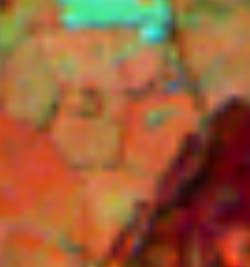
The Dublin Hills, bordering on to the Wicklow Mountains, have a long
history of forteana or macabre tales, with stories of 1920s civil war
executions taking place on lonely country roads, claims of World War
II 'UFO retrievals, and no end of ghost stories. A few miles
south-west of Killakee lies Poulaphouca, a major water reservoir and
site of an hydro-electric station. Phoulaphouca translates from the
Irish as the 'Ghost Hole'.
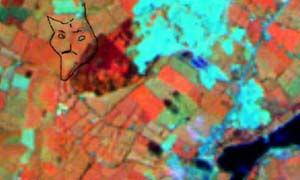
Recently, a friend of mine passed me these images, which was supplied
by his brother
who works satellite photography. It has been claimed that these images
show a 'devil's face' in the patchwork of fields near the reservoir.
On the left is a zoom in of the area, on the right the face is
outlined. How anyone managed to spot this is beyond me...
Back to the Hell-Fires: Black cats came back into the equation again
during the late 1960s, while the house was inhabited by a Mrs.
Margaret O'Brien, who was setting up an arts centre there. On moving
in, she was told by the local people that the area was haunted by a
black cat, alleged to be the size of an Airedale dog.
Mr. O'Brien did indeed see a big black animal disappearing into the
foliage one day, but didn't mention it to anyone until her artist
friend Tom McAssey and two of his colleagues were one night working
late in the house. They had a frightening experience with a black
draped spectre that spoke to them, and a monstrous black cat with red
glowing eyes. McAssey later did an oil painting of the beast, which
now hangs in the restaurant. Val McGann, who lived in a trailer next
to the house, claimed to have stalked the monster with his shotgun,
but was unable to corner it.
More paranormal events were to haunt the house, including apparitions
of nuns, poltergeists, power failures during planned seances, bells,
you name it. At one point, a Catholic priest was called in to sort
things out, to no avail. Things got even dafter when headgear - in the
form of small caps - were reported to be regularly teleporting
themselves into the house, and were to be found on picture hooks or
other odd places.
As if all of this wasn't enough, around the beginning of 1971, while
plumbing work was being done in the house, a shallow grave was found
beneath the floor, apparently containing the skeleton of a dwarf, and
a brass figurine, depicting a horned and tailed devil thumbing its
nose. Was this the dwarf that the Hell-Fires are supposed to have
murdered?
As far as I am aware, no one has ever gone out their way to *denounce*
the Irish Hell-Fires as Satanists. However, this wasn't the case with
the English group of the 1740-60s. Whereas the Anglo-Irish gentry of
the Dublin Hell-Fire club seem to have been little more than a ribald
bunch of hedonists, their English version were more a tad more
exclusive, and dare I say it, contrived.
To make matters more complicated, the English Hell-Fires didn't really
refer to themselves as such - they called themselves The Monks of
Medmenham or the Knights of St. Francis, after Sir Francis Dashwood,
the then Chancellor the Exchequer and founder of the group.
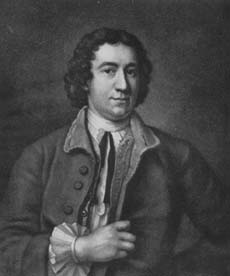
There was a core group of just 13 individuals, including John Wilkes -
a famous supporter of American independence - I believe there is even
a town in Pennsylvania named after him, and Lord Sandwich, he who gave
name to the snack - it's said that he was too busy playing cards to
dine, and instructed his servants to slap some meat between two hunks
of bread. The poets Charles Churchill, Paul Whitehead and Robert Lloyd
were also members. The others members were all well-known in their
day, but their names mean little to us now. However other *alleged*
members are still famous today, but I've found little evidence to
support claims of regular membership. These were Irishmen Lawrence
Sterne, author of *Tristram Shandy* and playwright Richard Brinsley
Sheridan - author of *The School For Scandal*. Also alleged to have
involvment was painter and engraver William Hogarth, who later fought
a stressful satirical war with Wilkes and Churchill through poetry and
cartoons.
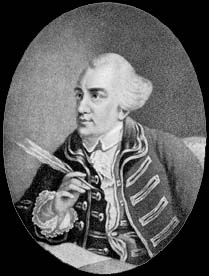
Well documented however, are the visits of Benjamin Franklin to the
home of Sir Francis Dashwood, between the years of 1764 and 1775, when
Franklin was an agent of the Pennsylvania Assembly. Dashwood, like
John Wilkes, was a supporter of American Independence, and Franklin
was free to come and go as he pleased from West Wycombe. It may
surprise some of you to know that Dashwood - head of the English
Hell-Fire club - and Benjamin Franklin - never the most religious of
men, collaborated on the *Abridgement of the Book of Common Prayer*,
mainly because they thought the original book of common prayer was too
boring!
One of the main problems I've come across while researching the
Hell-Fires was finding material written in any kind of sober manner.
I've had to contend with the likes of Daniel P. Mannix's *The
Hell-fire Club* - 'Orgies were their pleasure, politics their
pastime', and *The Hell-fire Club* by Donald McCormick - 'The weird
story of the amorous knights of Wycombe'. These pulp publications,
printed in the 50s and 60s, are not without their uses, as they are
indicative of the how the facts grow more lurid in the hands of
writers who seem to be getting some unspecified thrill from scaring or
disgusting themselves.
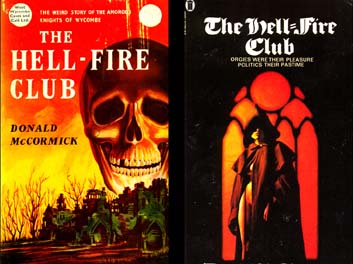
These writers, often unquestioningly regurgitating the claims of the
Hell-Fires enemies, spare nothing in their descriptions of the masked
swinging parties and drunken orgies which took place in the Chalk
tunnels built at West Wycombe by Sir Francis. I've been to these dark
damp tunnels - they're open to the public and available to rent - and
I can't imagine that they were the most comfortable places to hang out
in. Also, what these writers seem to ignore is that the tunnels were
created long after the heyday of the club. The Monks in fact used the
more luxurious venue of Medmenham, an old Abbey on the Thames, which
they had furnished for their uses, a bizarre form of retreat centre.
At the other end of the scale of commentators comes E. Beresford
Chancellor's *The Lives of the Rakes* from 1925, and the *The
Dashwoods of West Wycombe*, written by none other than the current Sir
Francis Dashwood. Dashwood never shies away from the possibly
scandalous behaviour of his ancestors, nor does he add fuel to the
fires of scandal, stating that the claims of Satanism only came about
in the 19th century, long after the demise of the members.
There is no doubt however, that the members took part in
mock-religious ceremonies, usually at the initiation of new members,
and the like. The main point of the gatherings, as John Wilkes put it,
was that
'a set of worthy, jolly fellows, happy disciples of Venus and Bacchus,
got together to celebrate women in wine and to give more zest to the
festive meeting, they plucked every luxurious idea from the ancients
and enriched their own modern pleasures with the tradition of ancient
luxury.'
Medmenham was indeed luxuriously equipped, with books and plenty of
food and wine. Servants were always on hand to attend to members who
stole away to Medmenham for a quiet night with their mistresses. The
house was littered with mottoes and suggestive sculpture - large
statues of the Egyptian gods Harpocrates and Angerona stressed the
oath of secrecy to which the brothers and sisters of the club were
bound. They even had a boat for Thames river trips, with a cabin of
scarlet canvas which could be rolled up. Propulsion came from a team
of four gondoliers dressed in white with red oars.
Of the contemporary material available, it's possible to get some idea
of what went on at Medmenham, without being encumbered with the
excited damnations of later days. Even some of the cellar book, taking
account of wine consumed, still exists.
No vows of celibacy were required by the members, male or female, yet
the latter considered themselves to be the lawful wives of the monks
during their stay within the monastic confines - 'every monk being
religiously scrupulous not to infringe upon the nuptial alliance of
any other brother'. In fact, so that the ladies would not have to deal
with the embarrassment of meeting their husbands, they first appeared
in masks - if they recognised someone they should avoid, they would
retire without giving themselves away.
A book called *Chrysal or the adventures of a Guinea* was published in
1766, telling the adventures of a coin as it passes from pocket to
another. Attempting scandal at most page turns, it's apparently
inaccurate in most details, including its portrayal of the goings on
at the Abbey.
The *Chrysal* tells of how John Wilkes smuggled a baboon into the
Abbey, dressing it up like a devil and hiding it in a great trunk in
the chapel. To the lock he tied a piece of string, which he hid
beneath the carpet. At some high point in the mock-religious
proceedings, Wilkes is supposed to have pulled the cord, releasing the
baboon, who was understandably a little irritated from being locked up
in the dark, and leaped upon the shoulders of Lord Sandwich who cried
out
'Spare me gracious devil: Spare a wretch who was never sincerely your
servant. I sinned only from vanity of being in fashion: Thou knowest
that I have never been as wicked as I pretended: never have been able
to commit the thousandth part of the vices of which I have boasted
of... leave me therefore and go to those who are more truly devoted to
your service. I am but half a sinner...
Quite a mouthful for a man with Satan on his back, isn't it? Both the
current St. Francis and Beresford Chancellor doubt that the author of
Chrysal was ever anywhere near Medmenham, as he obviously didn't know
that the chapel was a mere 21 by 19 feet, rather small to accommodate
13 members and a hidden baboon. There was definite animosity, on a
public level however, between Wilkes and Sandwich, culminating in the
*Essay on Women* scandal, Wilkes' various jailings and exiles, and the
mob riots, following the publication of the infamous No. 45 issue of
The North Briton in 1763, in which Wilkes insinuated that George the
III was acting against the nation's interest, as well as highlighting
as a host of other unsavoury royal scandals.
For over two hundred years, authors, with the exception of Sir Francis
and Beresford Chancellor, have had a wild time speculating about the
carry on of the Hell-Fire clubs, but always from some kind of supposed
moral high-ground. This has led to the supposition that their
mysterious quasi-religious ceremonies were of a satanic nature, and
not merely devoted to the gods of pleasure. However, it one looks at
their behaviour from a Christian viewpoint, it would be fairly easy to
assume that whatever the monks were up to, it certainly wasn't very
Christian... and for many, that which isn't of Christ, surely must be
of the Devil.
Only last week, the Southern Baptist Convention, the United States
largest Protestant denomination, published 30,000 booklets asking for
its members to pray for millions of Hindu souls. Hindus, the booklet
claims, 'have no concept of sin or personal responsibility', and are
in effect worshipping Satan. The SBC have also published booklets
soliciting prayers for Jews and Muslims. Quite a large chunk of the
Earth's population are Muslim, Hindu or Jew - are we to believe that
they're all Satanists?
It's often no better on my side of the world. Jon Downes, in *The
Rising of the Moon*, tells of rumours of 'satanic covens' operating on
Woodbury Common, in South West England, whereas the area is regularly
used by Druidic groups and Wiccans - even the U.S. Army now accepts
Wiccans.
Only a week ago, I was visiting a druidic group in rural Ireland.
Little statuettes of goddesses and the like are littered around their
land, but in amongst them male horned fertility gods can be found.
These people are not *Christian enough* to be Satanists, but do tend
to put away their horned gods when visitors of a more conservative
nature are about. I'm reminded of the infamous Rosslyn Chapel in
Scotland, home of numerous historical conspiracy theories. One of the
multitude of castings and carvings there is that of Moses, holding the
ten commandments, but with two horns upon his head. The current Earl
of Rosslyn reckons that this was due to a mistranslation of Exodus
34:29, as the Hebrew word *qeren* can mean either a horn or ray of
light...
I guess I could go on well into the night with tales of Accidental
Satanists - the plight of those, who, through no fault of their own
except their own taste for hedonism, the bizarre and the distinctly
*UnChristian* have become demonised as Satanists, much the same as the
beings of Greek myth were demonised, despite the earlier ideas of the
Neoplatonists who saw the daemons as being the intermediates between
gods and mortals.
On Thursday evening, before I left to come here, I was swapping emails
with a person in England who reckoned that the Hell-Fires *were*
Satanists, because they had been denounced as such. If that's how one
becomes a Satanist, then I'm your man.
During the summer of 1998, as some of you may know, I spent a pretty
strange two weeks in Norway, the exertions of which were captured on
film and are currently being shown on the Discovery Channel, in a
programme called *The Search for the Serpent*.
A dozen or so people from various walks of life had been gathered
together by a Swedish gentleman by the name of Jan-Ove Sundberg to, as
far as I was concerned, examine claims of a lake monster on lake
Seljord, a 10 mile long, 1 mile wide, 450ft deep lake in southern
Norway. What transpired was somewhat different. Jan seemed to *know*
that *The Serpent* - capitalised and singular - was there, and we just
had to find it, using echo sounders and sonars and other hastily
slapped together methods. Some of us didn't really like this approach.
If there's a new animal to be discovered, it's fair to say that there
ought to be more than one. The chances of finding a breeding
population of large previously unknown aquatic animals in a
land-locked lake are pretty slim, but finding some kind of beast that
can live for a long time and doesn't reproduce seemed even more
improbable. To cut a long story short, some of us got very tired for
the silliness and manners of Mr. Sundberg, leading to two of us
clearing out of there several days before the end of the 17 day trip.
(Read more about the matter here: http://www.bla
ther.net/archives2/issue2no16.html
Since then, Mr. Sundberg has been on the warpath, waging a campaign
against several of us, for spoiling his party. In my own case, this
has culminated in his building a website about me, titled *The
Infamous Dave Walsh: Right Hand of the Devil*, which alleges that I'm
a Satanist and a pornographer. To quote Jan:
'I believe he was possessed by his previous relationship with the
occult (and especially Satanism and his strange attraction to the
Devil). At one stage I even speculated that a sinister force was at
work at the lake and used Walsh as a tool. If you had seen what we
saw, you wouldn't be too sure either.'
The site mumbled on this fashion, giving all my contact details and
'accusing me' of several things that I would quite happily admit
anyway.
[After I made noises about legal action, a watered-down version
replaced the original. A copy of the original can be found at http://www.hellshaw.com/gustup/satan.html
]
Do I, ladies and gentleman, look like a Satanist to you? I'm just not
that Christian...
Irish Hellfire Club photographs »
Recommended: Geoffrey
Ashe - The Hell-Fire Clubs: A History of Anti-Morality
Photos of the Hell-Fire Club tunnels at West Wycombe,
Buckinghamshire:
http://ww
w.blather.net/archives3/issue3no1photos.html
No Smoke Without Fire - Irish Hellfire Club I
http://www.blather.net/archives2/issue2no25.html
Hellfire and Harlots - Irish Hellfire Club II
http://www.bla
ther.net/archives2/issue2no26.html
Hell-Fire Francis - The English Hell-Fire Club
http://www.blat
her.net/archives3/issue3no1.html
Hell-Fire Clubs: At Disinformation (by daev)
Killakee Country House Restaurant
- feedback and comments
- discuss with other blather readers
|

